The Fastest Couple in Britain
/Motorsport Magazine, August 1949
If you find a story below interesting, please click the "Like" button...Thank You!

Motorsport Magazine, August 1949

I’ve always had a soft spot in my heart for the Allard P1. Let’s be honest, it’s not the prettiest car in the world. However, when you compare it with the competition at the time, I think it was actually pretty attractive from a “form follows function” perspective. The competition featured a lot of chrome and sweeping curves that made them look more glamourous than they really were. Engine-wise, all of the P1’s compatriots at the time we powered by straight 6 engines (or less), while the P1 and Ford Pilot were powered by war surplus Flathead V8’s.
We’re all familiar with Sydney Allard’s 1st place finish in the 1952 Monte Carlo Rally. But the Guv’nors P1 was by no means a standard P1…it was more of a P1X, featuring coil sprung front suspension and a DeDion rear suspension. The flathead powering the car was also the more powerful Mercury 24-stud flathead with Allard dual carb manifold and aluminum heads*…plus a few other tricks that we don’t know about. When you think about it, the P1 was really one of the first muscle cars – in stock trim it was relatively anemic, but with a few of the option boxes selected, you could blow the doors off of just about any other tin-top on the road.
Unfortunately very few P1’s remain today, we know of a little over 40 cars out of the 559 cars that were built – and a handful of those 40 or so cars have been converted to J2 replicas. Even rarer is finding a running P1 here in the USA, we know of only 3 or 4. Fortunately one of those cars resides at the Tampa Bay Automobile Museum. The TBAM owns chassis #1885, which was originally sold through Bristol Street Motors on January 13, 1950. It was painted grey with a marron interior. The car was imported to the United States in 1958. The Emmanuel Cerf was kind enough to take me for a spin in the car and he even offered me the keys!
1885 is in very good mechanical and cosmetic condition. It has been lightly restored and maintains what appears to be the original factory build quality. The doors close with a solid clunk, but there is a fair amount of flex. The seats are comfortable and I must say the suicide door entry is a pleasure – it’s a shame the design is frowned upon today.
Driving the car was a bit of a mixed bag. Acceleration is quite good, especially when keeping in mind that this was a British passenger car from the late 40’s. The steering was heavy and the car wallowed a bit, but it was smooth at speed. My biggest frustration though was with the 3-speed column shifter. The shift linkage is quite complex, consisting of what can best described as a couple of scissor linkages that miraculously shift gears with a deft movement of the shift lever. I struggled with finding first gear from neutral – at one point the linkage jammed completely at an intersection. Fortunately the Cerf’s mechanic came to our rescue and was able to fix it after a few minutes. Apparently the scissor linkage can lock up on itself when handled incorrectly by a ham-fisted American like myself.
Other than that, the car was fun to drive. By no means does it handle like a ’56 Chevy Bel Air, but they are two completely different cars. A Chevy or Ford from the mid 50’s had the benefit of being created by hundreds of engineers and designers; and put together on a production-based assembly line. The J1, K1/2, L, M, and P1 cars essentially shared the same chassis layout with the only variations coming in wheelbase and a later switch to coil springs. Allard had just a few draftsmen & engineers; the cars were styled by Sydney and friend Godfry Imhoff! Even comparing Allard with its contemporaries of Austin, Alvis, Jaguar, and Triumph – what Allard accomplished with the P1 and the other cars was pretty amazing.
When driving the P1, I could imagine the car with 50% more horsepower, tuned suspension, and fresh tires blasting through the Alps like Sydney Allard. Sadly the shifter quickly brought me back to reality. However, with some more seat time I’m sure that I could come to grips with that blasted shifter. If I ever bought a P1, I would give serious consideration to converting it over to a floor mounted shifter. Sacriledge! I know, but in the name of drivability, it should be considered.
While the standard flathead was fairly anemic, it was easily tuned. In America, there was a wide variety of tuning parts available to the intrepid hot rodder. Unfortunately American tuning parts were nearly impossible to obtain in post war Europe – while exporting was essential to rebuilding post-war economies, importing foreign car parts wasn’t exactly at the top of the governments priority list.
-Colin Warnes
*The Allard dual carb manifold is a direct knock-off of Eddie Meyer’s manifold – it was replicated without Eddie’s permission. The Allard aluminum manifold was a direct copy of Edelbrock’s flathead manifold, which was apparently done with Edelbrock’s blessing. The parts were acquired by Reg Canham on a trip to the US in 1948 and smuggled back to Britain as carry-on baggage aboard his Trans-Atlantic flight.
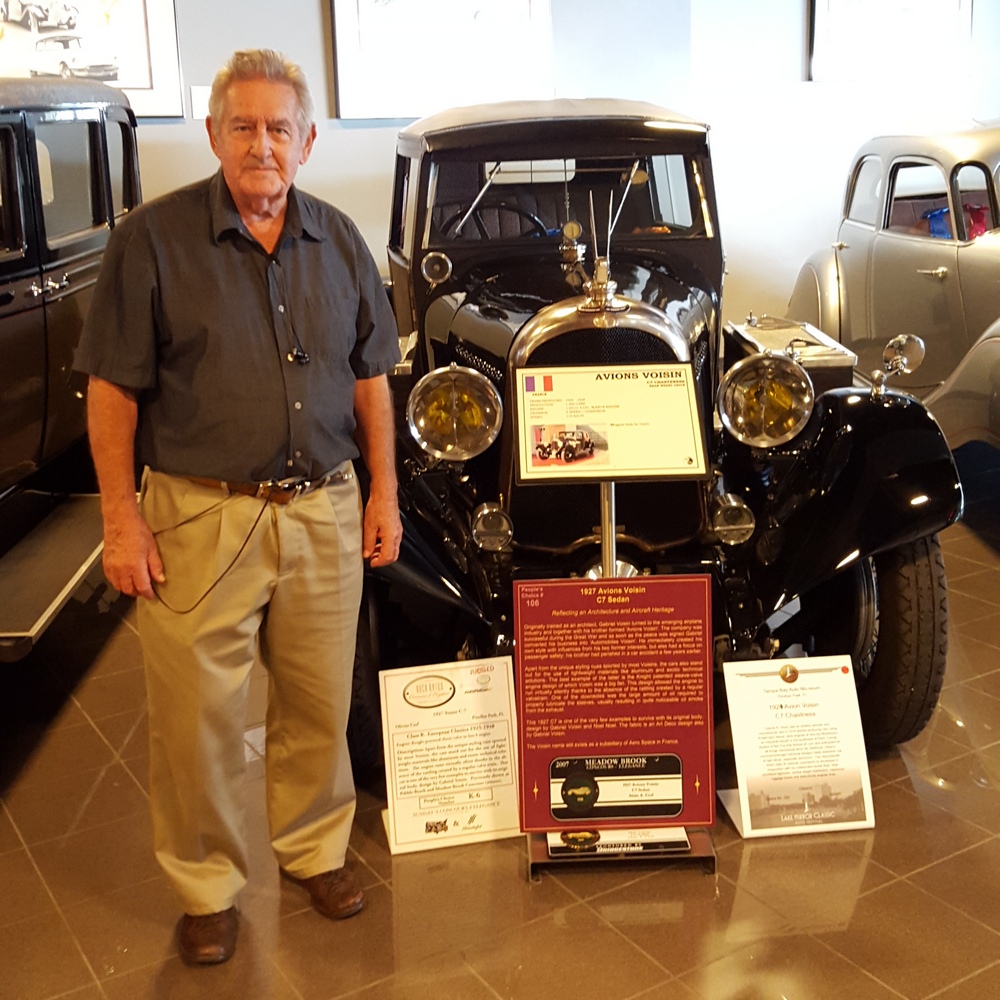
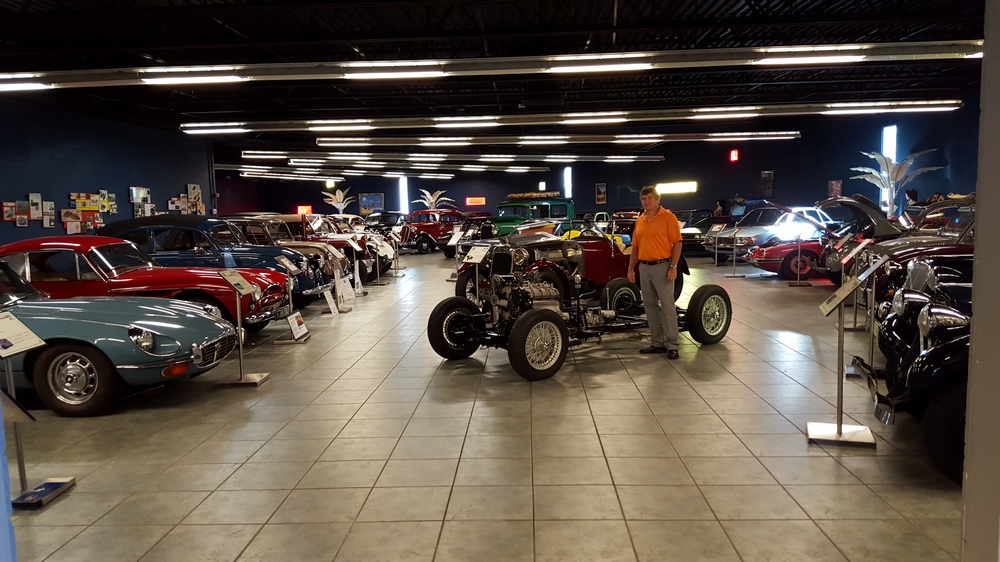
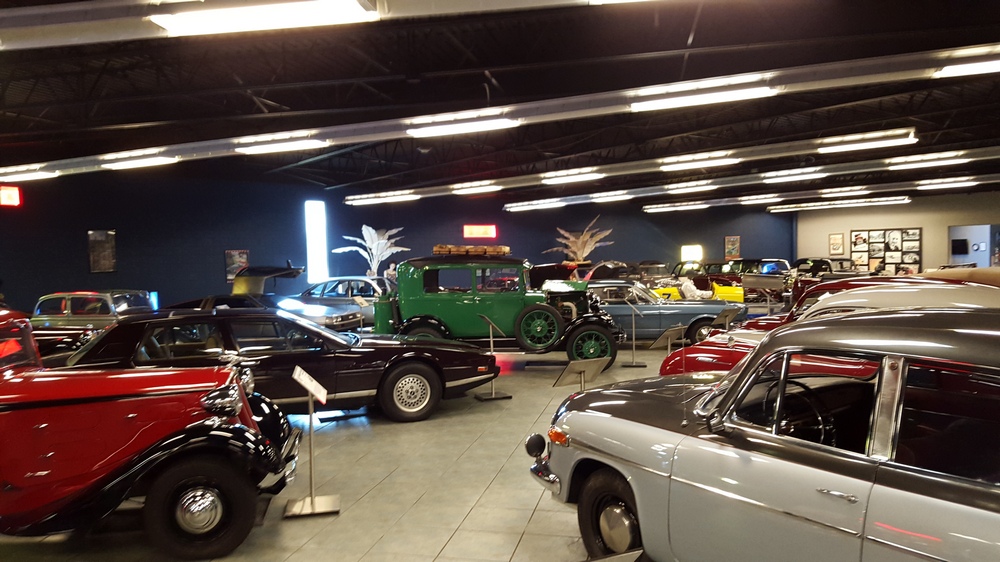
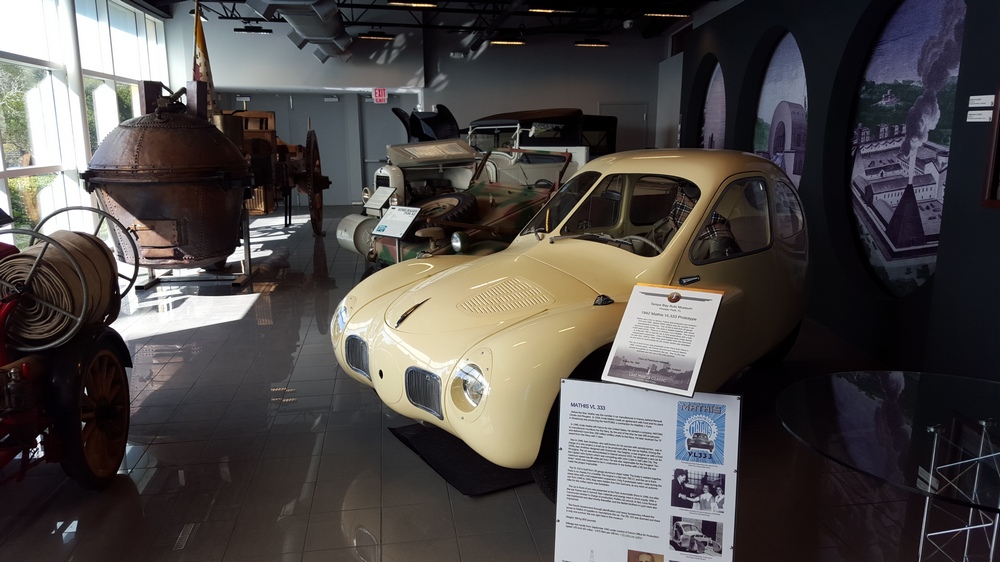
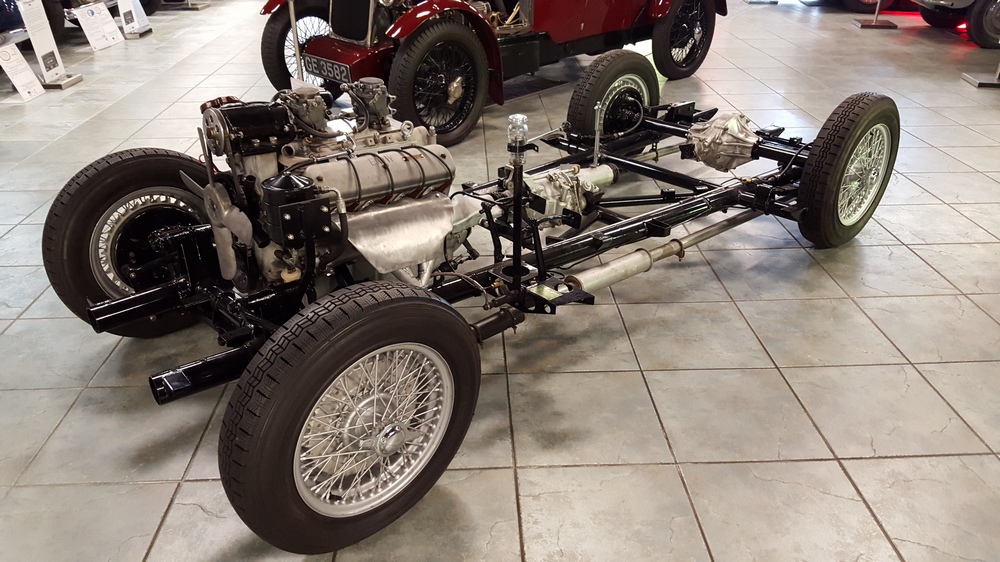
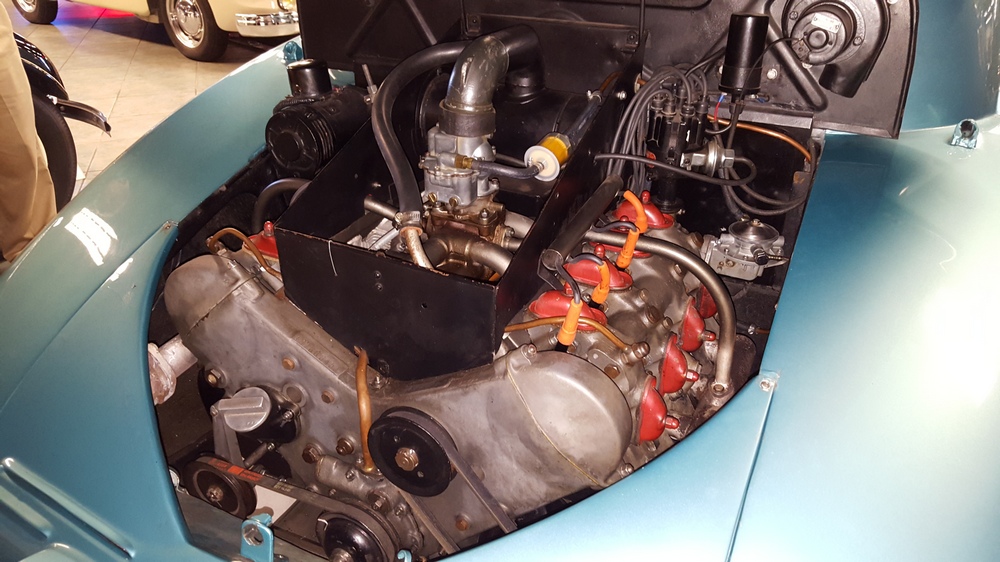
I am fortunate to have a job that allows me to meet interesting people and to travel around the country (along with some foreign destinations) from time to time. I work in the packaging machinery industry (the food you buy has to get in those boxes or bags somehow) and have been lucky enough to get to know the Cerf family; who are also in “the business” with their company Polypack. If you are an automotive enthusiast from the Southeast, then you are likely familiar with the Cerf family that hails from Tampa Bay, FL via France. Patriarch Alain, along with twin sons Emmanuel and Olivier run the company alongside their Tampa Bay Automobile Museum (TBAM) which houses a collection of eccentric automobiles that you will find no equal to here in North America. The collection is devoted to automotive engineering oddities and the unique personalities that created them. The TBAM also happens to own a very nice Allard P1.
Unfortunately my company doesn’t have any customers in the Tampa Bay area so I’ve never had a good excuse to visit the Cerf’s and their collection. However, this past November, the Cerf’s and Polypack hosted the annual meeting for our industry trade association (PMMI) – this was the perfect opportunity to see their cars and hopefully test drive their P1 (see separate road test).
As with most museums, the TBAM is a great place to host a party. Some of the cars were moved around to accommodate the caterers, wet bars, and a couple of hundred guests. This being a special event hosted by the Cerf’s, they gave us the VIP treatment. Are you familiar with the Fardier de Cugnot? It is the first self-powered vehicle, which was first demonstrated in 1770 by its builder Nicholas-Joseph Cugnot. The Cerf’s built a replica based of the original steam-powered Fardier which amazingly still resides in a French museum, although it is missing several bronze components that were “liberated”. The Cerf’s replica is authentic to the original, except for a few minor differences made to the boiler in the name of safety & usability – the original Fardier had a few critical design flaws because the technology was still developing. The great thing the about the Cerf’s Fardier is that it’s not a static display…they drive it! We were fortunate to get to see it go for a drive in the museum/company parking lot. Let’s just say that it isn’t fast, but it is an amazing technical achievement for a 245+ year old machine.
The TBAM is a litmus test for car nuts. When you walk in, you see all sorts of beautiful cars with interesting names. A fake car nut will casually walk around, taking notice of the DeLorean or the nice Mustang and then quickly leave. A real car guy will stand in front of the 1953 Hotchkiss and try to figure out how they managed to build an aluminum front boxer engined, front wheel drive car with an integrated transmission and transverse coil spring double A-arm suspension. A real car nut will notice that the Mustang is not just any ’65 Mustang, but that it features a Ford sanctioned Ferguson all wheel drivetrain and Dunlop anti-lock brakes…no doubt where Ken Block got the inspiration for his Gymkhana 7 Mustang!
There are just too many cars to highlight here, but some that deserve a close look are any one of their eight Tatra’s, the Avion Voisin - C7 Chastness (art deco masterpiece), the three-wheeled Mathis VL 333, the Ruxton, and the Gerin Aerodyne Prototype.
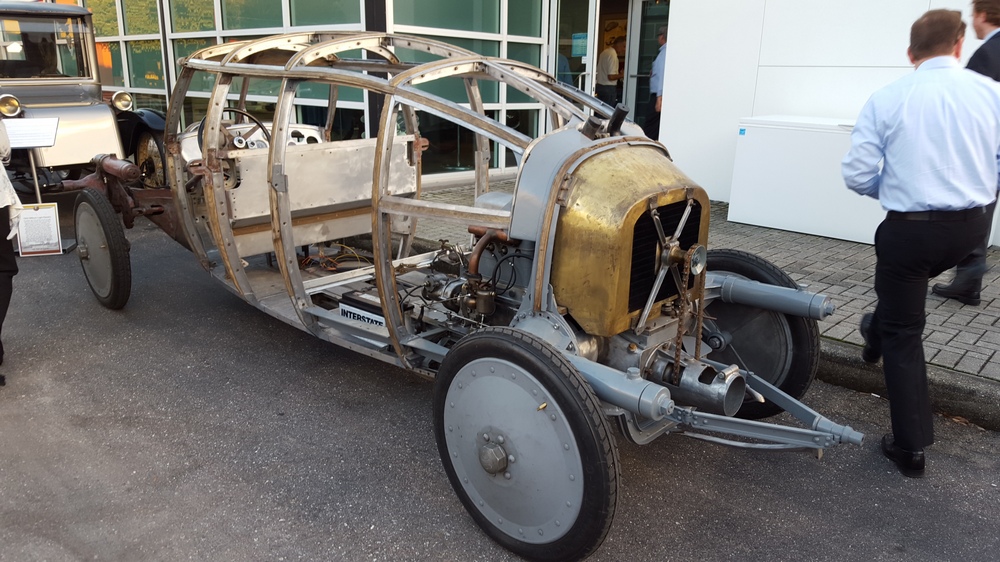
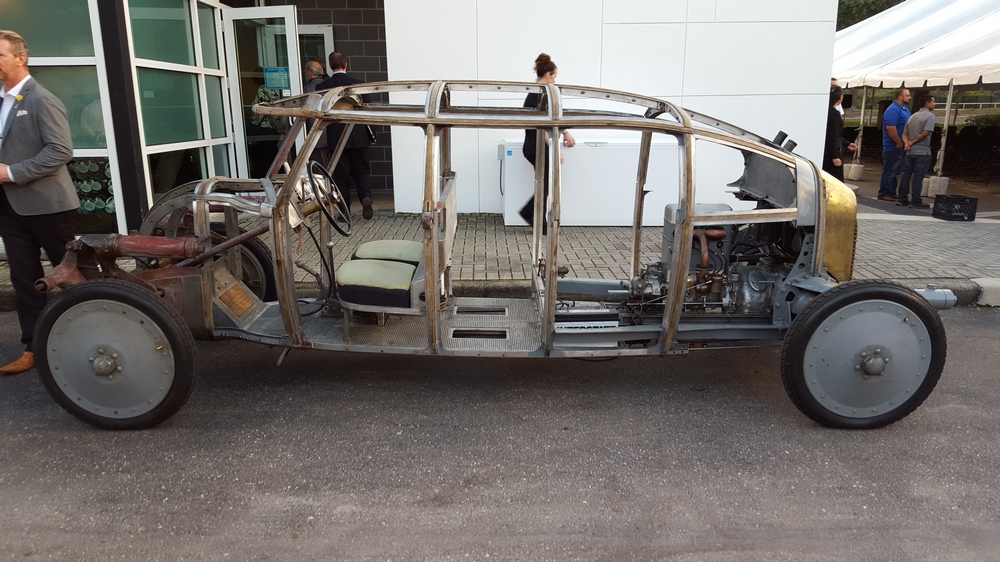
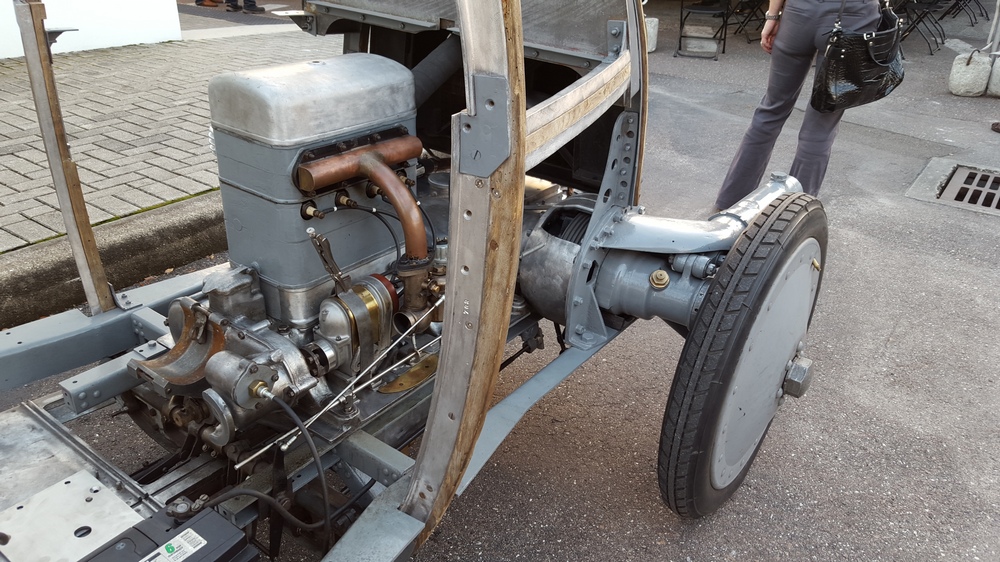

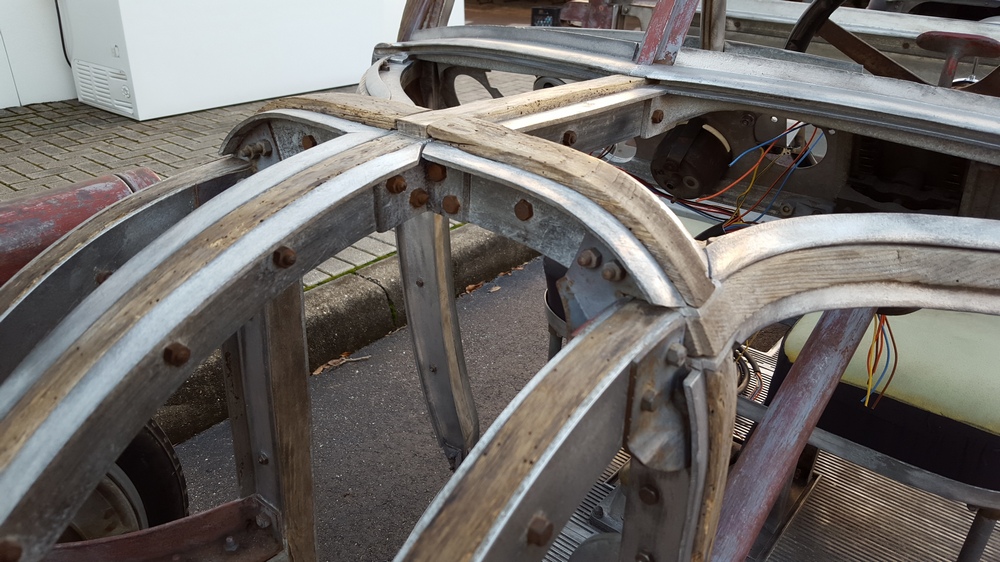
The Gerin Aerodyne is probably my favorite car in the collection, which also happens to be the most recent addition to the collection. The Aerodyne was built in 1925 by Jacques Gerin and features a very interesting laminated wood and aluminum aerodynamic chassis. The front & rear suspension, engine, and transmission feature some very complicated castings that must have been very expensive back in 1925 for this one-off vehicle. I could have stared at the Aerodyne all day; soaking in all of the intricate details.
In addition to the automobiles, the design aspect of the museum itself is a treat. Being French, it should be no surprise that the Cerf’s brought some style to the architecture of the museum. Additionally, the Cerf’s serve as patrons to the local art community and throughout the museum you’ll find a number of unique paintings and sculptures.
When you visit, you may be lucky enough to run into family Patriarch Alain. If you do, take some time to ask him about their self-designed & installed 1,000 panel solar array that produces 270 kW. Or you can ask him about petrol vs. electric vs. hydrogen powered vehicles…if you have strong opinions about any of them, be prepared to earn a thing a two about hydrogen power, of which Alain is a vocal advocate.
Next time you are in the Tampa Bay area, make a point to set aside at least a few hours to visit the Tampa Bay Automobile Museum…you won’t find a collection of cars like it anywhere in North America. The TBAM (www.tbauto.org) is located at 3301 Gateway Centre Blvd., Pinellas Park, Florida 33782 and you can contact them at 727.579.8226 or info@tbauto.org.
-Colin Warnes
The Road America Allard gathering and Jaguar event went very well. My brother Willy and I arrived Wednesday night before the event with the freshly restored E-jag , two TIGA Sports 2000’s, and the Allard J2X. By 9:00 pm we had them all unloaded into a track garage space and we were ready to start the weekend. Thursday was a test day – (which we didn’t pay for) so we focused on preparing the TIGA’s for Friday tech inspection (tires, fuel, battery charging, and nut-n-bolt).
Thursday night the weather brought heavy rain and I was VERY thankful for a water tight garage. The track reported that over 2 inches of rain fell overnight. Due to the threat of the severe weather we had a couple of nice cars “sleep over” in our garage: a 1957 Lister Jag (driven by Walt Hansgen to victory in the 57’ June Sprints and a gorgeous white 1953 Allard J2X - one of 2 steel wheel cars - both owned by fellow Milwaukeean and author Colin Comer. Needless to say the “sleep overs” were amazing…the next night we had a beautiful 120 Jag along with Jere Krieg’s Allard join us for the night. Friday was overcast and a bit cooler. Willy and I had good fun driving the TIGAS without much issue, other than we don’t get enough seat time and stay up way too late drinking and taking pictures of cars sleeping over!
For the Allard event Saturday, cars were displayed at the Road America Center. We had around 20 Allards show up, which I was told was a great turnout; by far the most I’ve ever seen in one place! All the cars were gorgeous and the folks that own them couldn’t have been more pleasant to spend time with. Of special note was Bob Girvin’s 1957 Allard GT Coupe (1 of 2 cars built) and the last car off the Allard production line. Saturday the weather turned spectacular, sunny and warm combined with the trees changing colors in the Kettle Moraine Area; it was amazing.
That night we all met at the Ostoff Resort in downtown Elkhart Lake for a car show called “Gather On The Green” where the 20 Allards and approximately 100 other beautiful cars showed up including a 120m jag, Lister Jag, 300SL,166 Ferrari among others (that I can’t remember) were displayed. Many of the cars in attendance drove a lap of the original road course, which was a blast. At the end of the night, after the cars were judged; we came home with “Best of Show – Allard Group” a distinguished honor for sure!
Sunday morning we put the Eddie Jones #9’s on the car (as it was in circa 1952) and I drove the Allard at Road America for the Allard parade lap. I wore Bill Cooper’s 1955 drivers’ suit and my father, Bill Porter’s helmet and we really looked the part. Having all 4 of Dad’s cars there (and all of them running!) was a special moment. Sunday afternoon and night we got them all home and put away, still running and strait which is always an accomplishment. Special thanks to Andy Picarrello, Deb Kornelli, VSCDA, and the great folks at Road America for making this a fantastic ELVF event!

Thanx to Andy Picariello & Tom Porter
Deb and Mike Korneli, organizers of the September, 2015 Elkhart Lake Vintage Festival (ELVF) contacted Andy in the fall of 2014 on behalf of the Vintage Sports Car Drivers Association (VSCDA). They asked Andy if he could get some Allards to attend their annual event at Road America. If so, Allard along with Jaguar, would be the featured marques at this event. Andy got the word out, and succeeded in getting 17 Allards there – including his own burgundy Hemi-powered J2 and his blue Cad-powered K2.
Events started that Friday, with an Allard display at the Road America Center, followed by the Driver’s Dinner at the venue. Saturday was a busy day, starting with the Road Course Re-enactment. This was a tour of the original road course, where the Road America event started 65 years ago. Several Allards attended this, along with the race cars and the display Jaguars. Following this, all the cars assembled on the lawn of the Osthoff Hotel. Andy Picariello’s J2 was placed beside Augie Grasis’ J2X. Both cars had competed against each other in 1953 – Augie’s being driven by Carroll Shelby, Andy’s by Dale Duncan. This was followed by an Allard dinner at Siebken’s Pub, arraigned again by Jere Krieg. Sunday was the race day. Allards were afforded a parade lap before the feature races.
Andy had hoped that 4-5 Allards would be racing, but in the end was glad that two J2X’s would be able to thrill the crowds with their on-track bravado. Augie Grasis was at the wheel of his Carroll Shelby veteran. He started in second spot on the grid for Saturday’s Sprint Race, quickly took the lead, and had a great time dicing with a ’33 Ford Indy car to his first place finish. The Elkhart Lake Road Coarse reenactment tour was soon to follow – a great show for the spectators, but the slow stop & go driving caused heating problems for Augie’s Allard. The result – a blown head gasket that relegated his J2X to a static display role for the rest of the weekend.
Vince Vento decided to enter his J2X just ten days before the event. Through diligent efforts on the part of his team and a certain measure of luck, he was able to get his car set up and delivered in time. Vince was experiencing some shifting problems with his Hydramatic during practice, so he prudently decided to forgo Saturday’s Sprint in favor of Sunday’s Allard/Jaguar Feature Race. Throughout that event both Vince and the race fans had a wonderful time experiencing and witnessing the Allard’s adrenalin imbalance as he wrestled his beast to a respectable finish.
Tom Porter had a great time piloting his Allard J2X on the Allard Parade lap while wearing a 1955 driver’s suit and his late father’s vintage helmet. Bill Porter, incidentally, had owned and raced all four of the Porter family’s cars (a Jag E-Type, the J2X and two TIGA’s) at Elkhart Lake, so Tom and his brother Willy felt this occasion was especially nostalgic. Tom’s weekend was topped off when his J2X won “Best of Show – Allard Group” for Saturday night’s Gathering on the Green.
The J2X field was filled out by Colin Comer and Barb Pinkenstein who brought their Allards over from the local Milwaukee area, along with Richard Hansen’s and Jim Netterstrom’s J2X’s.
The J2 contingency was represented by Andy Picariello’s and Dana Mecum’s cars, along with Tony Cove’s ‘work in progress’ J2 that he trailered over from his home in Ontario. Many an Allard owner is intrigued by the opportunity to inspect an Allard project car that effectively displays so much of an Allard’s unique ‘innards’. Seeing these projects also gives encouragement as we work on our own projects. Keep up the good work, Tony!
Bob Girvin’s unique Hemi powered Allard GT (one of two Allard GT’s, the last production Allard, and the only GT set up for racing), and was honored with the well deserved People’s Choice Award.
The rest of the Allard field was rounded out by the three pristine K2’s of David Gaunt, Peter Zimmerman and Andy Picariello, Tom Kayuha’s K1, Terrill Underwood’s L-Type, Jere Krieg’s Palm Beach and Wilson Ryder’s J2X Mk II. Harold Haase made the trip from his home in CT – but alas, without his original and well preserved J2X – which is now on the way to its new home in Belgium.
Per Andy, it was a memorable event, thanks to the hospitality shown to us by all involved. Deb Korneli did an outstanding job to assure that we had a good time. Jere and Julie Krieg served us well as our social secretaries. The long journey for most of us was well worthwhile.
The "King of Kustomizers," George Barris passed away today, he was 89. So why should Allard owners care? Well, Mr. Barris layed his skilled hands on at least one Allard that we know of...a K2 chassis 3021. The car was originally sold through Noel Kirk and it was painted blue with a red interior. That soon changed when actor Jeff Cooper bought the car in the mid 60's. Jeff commissioned George Barris to modify the body and Von Dutch to paint the car.

It's hard to see in the photo, but Barris added stylized spats to the rear wheels and it appears as though the door hinges were changed from rear to front mounted. Did you catch the other modification? Look at the headlights; Barris covered over the headlights and mounted them on a custom bumper...very cool!
Unfortunately this is the best photo we have of the car, which was from Amelia Island several years ago. If you have any other photos...please share them with us!
-Augie Grasis
Allard and Elkhart Lake. Carroll Shelby and Elkhart Lake. Carroll Shelby and the Allard. All linked together in sort of a “six degrees of separation from Kevin Bacon” way. Allards have been inextricably linked with Elkhart Lake as they dominated the front of the field in the early ‘50s when the races were held on the roads and streets surrounding Elkhart Lake, Wisconsin. Burt Levy immortalized the Allard in his story The Last Open Road, which culminates at Elkhart Lake and features fictional ex-RAF-fighter-pilot-turned-racer Tommy Edwards wrestling his Allard in famous tracks across the country. Real life drivers such as Fred Wacker truly did race Allards on the open roads surrounding Elkhart Lake.
Carroll Shelby started his career in an Allard. As a matter of fact, he drove MY Cadillac powered Allard J2X (#3146) in 10 races in 1953 and won 9 of them. In January 1954, Shelby raced the car #11 the 1000KM in Buenos Aires Argentina. His 10th place performance (with co-driver Dale Duncan) landed him a ride with Aston Martin and the rest, including a LeMans win, is history. And Shelby is a legend at Elkhart Lake too where he won the Road America 500 in 1957 in a Maserati and later dominated with his Shelby Cobras.

Needless to say, when George, Mike and I learned that Allard would be the featured marque at Road America for the Elkhart Lake Vintage Festival we were excited beyond words. We wanted to make a good showing among our Allard brethren. We were excited to show the racing world the coolness of one of the most successful combinations of sports car and hot rod. And mostly we were excited to run the Carroll Shelby J2X at Road America—a true horsepower track. We raced there in July 2014 at the Hawk and it was awesome—heart-stopping acceleration, diabolical Allard swing axle handling punctuated by non-stopping brakes! A true 50’s hot rod sports car experience.
We put our learnings to work in our preparation. A taller rear end would get us to our 5500 red-line at the end of the straight. Racing brake linings would stop us better for turn 5. No need to work on the motor—sounded strong to us!
Besides the mechanical work to prepare for the race, we began corresponding with Andy Picariello, the Allard Reunion organizer and were surprised and disappointed that, though there were 18+ Allards entered for the weekend, we were the only ones thus far who planned to race. Then, at the 11th hour, enter Vince Vento with his J2X. Vince is a new owner of a beautiful black Cadillac powered J2X, and one of only two with a hydromatic transmission.
Vince’s car had been used as a prototype by Zora Duntov in designing the 1955 Corvette.
Vince and his girlfriend Estelle, are brave, optimistic people. Vince decided just 10 days before the event that he was going to race. While running his business and traveling for other events Vince arranged new tires, new brakes and shipping from Florida to Wisconsin for a car he had never raced, over his cell phone. Though I have often heard in my business life that “hope is not a strategy,” Vince’s optimism and hope were clearly the core of his plan!
Our caravan, including Dan & Brenda’s motor home, rolled into Road America Thursday night. After setting up camp for Team Allard and going through tech we headed for Siebkens for a couple of pre-race beers and the world’s #1 race bar. Surprisingly we arrived at the track Friday on time and ready for the first of our two practice sessions. Vince and Estelle found us, but couldn’t find their car, which was supposed to be shipped to a tire dealer to get racing tires mounted. After several phone calls to the driver and tire guy and many rental car miles, the tires were finally mounted and Vince and his black beauty arrived at the track for the afternoon practice session. The shakedown sessions for both J2X were successful but not without some challenges. The hydromatic transmission on Vince’s car was slipping out of gear and not shifting properly. While the #11 Shelby Allard set the fastest time for the group, we experienced a late session spin which we later learned was from a differential oil leak spraying oil on the right rear tire.
Friday night Road America hosted a dinner at the track for the competitors Friday with all 18 Allards on display. Despite the cool temperature, the threat of rain, and the free beer inside, many of the racers from other classes spent an inordinate amount of time drooling over the fabulous gathering of Allards. Just as the party wrapped up it started to rain; and rain it did, all night until morning.
Qualifying for our group was scheduled to be first on the track on Saturday morning. While it had quit raining an hour before our group went out, the track was slick as snot and the group 1 drivers tiptoed around the turns. In the meantime, Vince decided that, given the transmission issues, he would forego any preliminary sessions and save the car for the Allard/Jaguar feature race on Sunday. In the end, the #11 had qualified second behind a well driven MG for the afternoon’s Sprint Race.
Saturday’s Sprint race turned out to be a real barn burner. Our #11 Allard took the lead from the start followed closely by the 1933 Ford Indy car of Rex Barrett. The two cars were never more than a couple of car lengths apart the entire race, but the Allard ultimately prevailed by a mere .5 seconds at the checkered flag.

There was no time to celebrate as the Elkhart Lake Road Course reenactment was immediately following our race. The parade of 15+ Allards, many Jaguars and an assortment of other racing sports cars toured the 1951-52 road course around picturesque Elkhart Lake to the waves and applause of fans and locals on lawn chairs in the countryside. The track finally weaves its way on to Main Street where hundreds of race fans are gathered to see, hear and smell the fabulous cars of the past.
I am sure the reenactment was a fun experience for most drivers, (it started that way for my bride Pami and me) but soon became stressful and worrisome as the temperature gauge pegged out as we approached Main Street. A blown head gasket proved to be the end of our race weekend as we finished our “tour” with Pami at the wheel being pushed down Main Street by the crew and myself.

Undaunted, we found our place in the Gather on the Green Concours at the Osthoff Resort facing Elkhart Lake, with a stunning display of 18 Allards of all types. After our long push down Main Street we decided to leave the #11 in “as raced” condition, adorned with the oil, radiator overflow and grime of the track. We were placed next to Andy Picarillo and his famous J2. Our cars had met before—at a West Texas Air station SCCA race! Andy brought a photo (below) from 1953 of our cars on the front row, his driven by Dale Duncan and the #11 by Carroll Shelby. The weather was fabulous, the company was interesting, and the cocktails were flowing—life was good, despite our broken car!

Dale Duncan in #54 and Carroll Shelby in #11

Dana Mecum’s J2. Carroll Shelby drove a couple of races in this car in 1951.

Andy Picariello and his two brides!
Sunday dawned a fabulous day and it was all hands on deck in the Allard pit, to help Vince make a good showing in the Allard-Jaguar Feature Race. The grid truly looked like a blast from the 1950’s as Vince was lined up next to the ex-Briggs Cunningham Lister Jaguar from the Collier Collection. Vince drove an inspired race as he lowered his time on every lap. Estelle and I watched from turn 5 and were sure we could see Vince grinning through his full face helmet every time he hammered the big Cadillac motor up the hill! As the checkered flag fell on this beautiful black J2X, it was mission accomplished and a strategy well played!

Vince Vento in his gorgeous J2X
As we packed up for Kansas City and bid farewell to our old friends and our new friends, I noted a little smile on George and Mike’s faces. Was it the satisfaction of a good race weekend? A successful gathering of so many cool cars?
Or maybe it was the anticipation of tearing into that Cadillac motor when we arrived home! Until next year

The #11 Crew—Brenda & Dan Rapp, Mike Caraway, George Hull and Pami Grasis
The good folks at Car and Driver magazine have put together a clever Periodic Table of Sports Cars. The table is arranged much like the traditional Elemental table...but this one is much more interesting. Even an Allard J2 made the list!

Have you ever tried to find Allard videos on YouTube? You can search for terms like "Allard" "Allard J2" or "Allard Race", but you'll often get a whole bunch of non-Allard car related videos. Fortunately we've made it easy for you. Just go to our YouTube Channel: https://www.youtube.com/user/allardregister. There you'll find 150+ Allard related videos ranging from in-car race footage, vintage footage, movie clips, etc.
Navigating to our videos can be a bit of a pain, especially since YouTube is always tinkering with their web site interface. Here's a few tips on how to get around:
If you have an interesting Allard video that you would like to share on YouTube, but are unsure how to do it, click here to contact us about it. We can either help you do it...or do it for you.
Bruno Rigoli racing his K2 at the Circuit des Remparts in Angoulême.

Dennis Simon created the print above for the Allard Register back in 1990. Honestly, we think it's one of the best Allard prints out there. Dennis still has several of these 6 color silkscreen posters available from an edition of 95 posters. The 24x36" prints are signed and numbered. They are available for $175 each, which includes postage. For more info, go to: http://www.centuryofspeed.com/Dennis_Simon/Poster_Originals.html

Hi there,
Please below find below a few lines concerning the work done on my Allard - I had planned to provide a comprehensive update for the Allard Register. After my Alpine trip, now I have to do this differently.
- October 2011: Obtained the Allard at RM Auction in London (99J2089) built 1951
- It came from the US, but the car was originally delivered to Cuba
- The car came equipped with a 8.4 ltr Cadillac and Hydramatic automatic gearbox, which I found unbearable. It got awfully hot and the automatic and the huge weight on the front axle made driving it unpleasant
- I decided to swap the engine and bought a complete correct engine (331. ci / 1950) - and had the auxiliaries added to it (pretty challenging)
- Work was completed earlier this year (to a state where the car was drivable) - but not completely finished (shocks , instruments to be fettled with)
- It took quite a while to find a mechanic who was brave enough to get on the Allard - after an initial drawback I convinced my mechanic who deals with my 1964 Mercedes to work on the Allard with the help of a Corvette race mechanic who did the engine work.
- Drove a couple of hundred kms to run the engine in - and then joined my fellow vintage car folks (from the Talbot Club) - for a tour through the Alps.
- The Allard went like a rocket - everybody was stunned by power and the verve
- Finally axle broke just on top of the Furka Pass in Switzerland (2.400 m / 7.200 feet) - fortunately w/o any other damage neither to Car nor driver.
- Enjoy the photos!
Fred H.





One of our hobbies is tracking down the history of old Allards. This can be a time consuming pastime, but fortunately there are others that share this same interest. A few years ago, we were contacted by Canadian Rupert Lloyd Thomas. Rupert was interested in a Canadian J2X that he had come across a few photos of. According to our records, only nine Allards were exported to Canada, but only one of which was a J2X. We were able to determine that the car was chassis 3209 (one of the last built).
Recently, Rupert was rewarded for his hard work with a drive in the car by its current owner, Al Sands. He writes, “I thought you would like these photographs taken by myself at the Hockley Valley Hill Climb Revival in Ontario, Canada on July 2nd 2015. Driver Al Sands, accompanied by Don Haddow, all-time hill record holder in the Jordan Special. Many thanks to Al Sands for driving me up the course in the Allard.” What a treat to get to enjoy a drive in the car you’ve been searching for.

Here’s the story of J2X 3209:
The Allard Register archives: 3209 was originally painted beige with a red interior and crimson wire wheels. It was exported on May 15, 1953 to Canada via Budd & Dyer who were located on 4269 St. Catharine St. W. Montreal, Quebec. Per David Anderson Charters, Alec Budd of Budd and Dyer Ltd were the importer and distributor of Jaguar and Alfa Romeo; he was a rallyist and a sponsor.
Per Al Sands, the original owner was David Gurd of Quebec. The car was then sold to Richard Mauron of Toronto. Mauron raced MG's in the early 50's. Rick Mauron’s father owned a Swiss Chalet restaurant in Montreal and Rick opened a Swiss Chalet in Toronto, near Varsity Stadium. He raced the Allard at the Canadian National Exhibition in 1955. He pranged the front right and got rid of it and bought a 300SL Gullwing.

The car then passed onto Fred J Hayes, although he soon advertised the car in the January 1956 issue of Road & Track. The ad read “ALLARD J2X. One of last produced, mileage under 5000, condition original and immaculate, modified Cadillac engine, Jaguar gearbox, wire wheels, side mount spare. Offers to Fred J. Hayes, 79 Bideford St., Downsview, Ontario, Canada.” Hayes apparently failed to sell the car in 1956, as he was racing the car until 1957.
The car was painted red in 1955 and registered 42 347 (per the picture at Rattlesnake Point), then black in 1956 with registration 87 780 (per the picture at Harewood). Digging into his files, photographer Roger A. Proulx came across the photo below - the Cad-Allard seen here in the pits after putting up the fastest time of the day with Fred Hayes at the wheel during the Rattlesnake Hill climb in 1956.

The car then passed to Dave R. Pidgeon of Oakville, Ontario. Registration for 1958 is 415 986 (Per http://www.flickr.com/photos/50312897@N02/5451713273/ “Photographed in Oakville Ontario Canada on Kerr Street in 1958 this Allard J2X was owned by a nephew of screen actor Walter Pidgeon. As a resident of Oakville and working in Toronto it was on sunny days his daily driver.”

3209 then appeared on the cover of Canada Track & Traffic in October of 1959, and was registered as 106 757. It was then offered for sale in the July 1961 issue of CT&T, “CADILLAC-ALLARD J2X - Superb track and road car. Particularly suited to hill climbs, as featured on CT&T cover, October 1959. Maintained in top condition. Engine set up by Detroit Racing Equipment with 4 2-throat carburetors, solid valve lifters. Corvette 4-speed transmission. Finished in bright blue, red leather. Not suitable for beginners or those with a "heavy foot". D. R. Pidgeon, 143 Wedgewood Dr., Oakville, Ont. VI. 4-3044.

Dave Pidgeon was unable to sell the car in 1959, but finally sold in January 1962 to Al Sands for $2,000. Then a photo of a J2X surfaces with Ontario plates from 1970 at a car show held at Harewood with registration 370 286. Al Sands is in the photograph, on the left in the flat cap. As noted above, Al still owns the car today (over 50 years!).

Why did the car have so many different registration plates? J. Scott Morris explains, “Regarding licences; at that time registrations occurred annually so it is almost impossible to follow one car by the licence plate in Ontario in the 50s - 60s. I do not recall off-hand when the system changed.” At renewal you bought the metal tag and got the next number off the pile!

If you are an automotive enthusiast, the Monterey Car Week cannot be missed. If you have the means and have not attended yet, you should make your reservations now. There simply is no other event in the world that brings together such a diverse range of cars. The only disappointment has been the steady decline of Allard’s on the Monterey Peninsula – be it on the track, the show lawn or the roads. However there is never a shortage of Allard enthusiasts on hand.
Steve Schuler was on track at the wheel of his Allard J2 (3rd place finisher of the 24 Hours of Le Mans in 1950) bracketing this year’s nine day Monterey Car Week. Steve’s week began with the Monterey Pre-Reunion at Laguna Seca Raceway on August 8 & 9, and concluded on Sunday, August 16 where he raced to a 7th place finish at the Rolex Monterey Motorsports Reunion – despite the fact that his brakes went out in the early laps of the race. Steve had a busy weekend as he was also racing his insane IMSA Roush Mustang that keeps trying to destroy itself.
Three Allards were on display at various car shows in the course of the week. David Rossiter showed his immaculately re-restored red K2 at Tuesday’s Concours on the Avenue in Carmel, and on Wednesday Martin Allard’s cream-colored K3 earned the Blessed and the Best of British Cars award at the 3rd Annual Carmel Mission Classic. Jim Taylor’s unique red & white J2X was one 150 vintage sports and racing cars gracing the prestigious field at The Quail – A Motorsports Gathering on Friday.

On Friday we had a nice visit with Jim & Lisa Stec, who came out from Wisconsin to witness the sale of their Allard K3 at the Bonham’s auction. This K3 also happens to be the car that my son and I rebuilt and traded with Lisa’s uncle Paul a couple years ago. Paul passed away a few months ago and the family regretfully decided to divest themselves of much of his eclectic collection of preserved classic cars. We were all on pins and needles when the K3 drove up the ramp. Although the car did not hit the $100,000 estimate, it did sell for a respectable $87,500.
Martin Allard invited me to join him on his annual Thursday morning ‘mini-tour’ toward Big Sur to witness a part of the Pebble Beach Tour d’Elegance as the tour participants traveled out to Highway 1’s iconic Bixby Creek bridge before returning back to go on display on Carmel’s Ocean Avenue.
On Sunday morning, three generations of Warnes’ rolled out of bed at 4:30 am, and with credentials in hand, partook in the Pebble Beach Concours d’Elegance ‘Dawn Patrol’. Despite the early hour, it is a special privilege to gather on the 18th fairway of Pebble Beach Golf Links to witness the Concours entrants make their way onto the show lawn at the picturesque Carmel Bay.

While there were no Allards in this year’s field, Jim Taylor showed his 1954 Cunningham C-3 Vignale Coupé where he earned 2nd in the Post War Cunningham Class. We also had a nice visit with Wayne Carini (“Chasing Classic Cars” on Velocity Channel). Wayne was sharing his enthusiasm about the Allard J2X that he recently purchased from long-term owner Bill Bauder. Wayne plans on keeping the car in his personal collection and has big plans to enjoy his new toy.
It may a be a bit premature, but you may want to pencil in the dates for Car Week in 2017…we’ll keep you posted if anything interesting develops!
One of our favorite things about publishing this website are the interesting people that find their way here. We received an email the other day from Roy Walter who used to work at the coach builder Hilton Brothers. Hilton Brothers were responsible for building the saloon (P1) bodies. Below is a brief look at what life was like for those who built our cars.

When I was in the forces it was an offence to keep a diary-I suppose it was in case of capture and the subsequent betrayal of serious secrets,-so I never got into the habit, and I've always regretted it. I have problems with dates, but I think I went to work for Hilton Brothers in early 1951. Panel Beaters were an elite bunch in those days, we were mostly head hunted. The factory was basic in terms of plant and facilities. The Coachbuilders or chippies (wood workers) as we called them were upstairs on the first floor where the offices were. One of the Hilton Bros was the boss up there and we seldom saw him. For that matter we didn't see the other brother much either. The Panel shop was run by a certain Bill Merritt.
The completed wooden bodies came down to us in a large lift, and we "tinbashers" formed the aluminium panels. Two guys were responsible for the roof panels, which included the cant rails, the peak over the windscreen and the two panels forming the rear light. I usually took care of the sides over the rear wheels, the boot panels and surrounding bits. Another guy did the boot lid and both doors. All these panels had to be welded together, and during this time, the skeleton skin was supported, resting on the peak at the front and the boot at the back. When the whole thing was finished and tarted up, we all lifted the skin up manually and dropped it on to the wood body, where it was fixed on by panel pins under the body. Such sophistication!
We used mostly 18swg aluminium sheet. We usually cut our own panels up from patterns hung up on the wall. Welding was done by the usual method, OXYGEN and Acetyline bottles. One of us held up the panels to be joined, the other one welded them. We didn’t work in pairs; we just called out for help when needed. The one pair that always worked together was the pair who did the roof panels. These were too big for one to handle on a wheel, so they travelled a bit backwards and forwards from one side to the other then back the other way until the panel had enough shape. Then they welded on the surrounding panels. Hilton Bros never had a power hammer-they frightened the life out of me anyway. We rarely used hammers at all. Mostly it was bashing them judiciously with mallets, bossing mallets and sandbags, then smoothing them out with the [English] wheel. The welding process distorted the panels, and we took care of that with a flipper in one hand and a handweight in the other.
I think there were six of us altogether, not counting the old feller who was a wingmaker. He had been a pre-war wingmaker in the British motor industry, forever telling us how easy we had it. There were a number of other guys who worked on the same floor. They were "fixers." They secured the panels to the wood frames, secured the bonnets, boot lids and doors, plus windscreens. Then the bodies went back upstairs to have the trim installed. Yes, the chippies made the frames for us to work to, but we didn't often get to see them. I mentioned Bill Merritt before. He was the panel shop foreman, responsible for inspecting everything we made; a man with an eagle eye. When he wasn't inspecting, he would help out on the floor. A nice guy. Came from a long line of undertakers so he said, recounting with great gusto some of the gory details.
All British factories had a tea break at 11:00am and usually 3:30pm. We didn’t have a luxury canteen .We kept some planks against the wall, formed a circle with some drums and that was our "canteen." Washing was even more basic; a bucket with cold water and a bar of soap! The toilet was a disgusting old urinal. Eventually, we became fed up with all these primitive conditions, and making no headway at all with Messrs Hilton, we went on strike! All we got was promises, but luckily I got an invitation to work at Hoopers on Rolls Royces later on in 1952. Same sort of money but much more civilized. Sadly none of the old coachbuilding firms exist anymore. Even the Rolls Royce bodies are made in Germany from pressings then tarted up before sending them over here.
Hoopers was an entirely kettle of fish, in that everything was organized. The chassis came in with the customers name on the windscreen, and we tinbashers worked in gangs of five to a car. The gangleader was paid for the whole car and we divided that price by mutual agreement between us, which worked out quite well. Mostly we were doing Silver Clouds , sometimes the occasional Bentley. My contribution was doors, which was challenging because the wing shape ran right through the doors. There was no getting away with any slack. The inspector wore sugar bags when he worked, and I don't think I ever did a door without his chalk marks on it. I was there about eighteen months.
I only left Hoopers after pressure from my father, who, whilst in his late seventies started a business making shopfittings. My brother, an artist designed the product and made all the tools for him and the business took off. So much so that the whole thing ran away with him. Unless he could find someone trustworthy to organize things while he was outselling it was going to fall apart. Within a year our turnover was a million pounds annually. I had ceased to be a panel beater and became a Company Director. My life story stops here. I only mentioned it because I needed a good reason to give up tinbashing!
PS: I had a big disappointment some months ago. Driving on a local motorway in driving rain, I actually overtook an Allard saloon. I couldn’t make him understand my frantic hand signals. He probably thought I had an ulterior motive and I gave up in the end as I had to be elsewhere. The first Allard I had seen for sixty odd years too, and I wanted to tell him we were connected. Ah well. Ce Le Vie!
Thanks for sharing Roy!
We are pleased to present the first J2X, chassis 3128 for sale. Please click here to learn more about this historic vehicle.
Graham Smith

Tom Hawkes caresses his powerful Allard around the twisty, challenging gravel confines of South Australia’s Collingrove Hillclimb at its inaugural, public, 15 March 1952 meeting…1st in the over 1500cc Sports Car class. (State Library of South Australia)
Chassis #99/J/1731 fitted with Ford Pilot engine # 5338/26 was the first of 6 Allards imported to Australia, the car arrived in September 1950 to Rube Gardner’s order. Gardner was appointed the local concessionaire having travelled to the UK to do the deal with Allard himself early in 1950. Gardner’s premises were on the Princes Highway, Carlton, a southern Sydney suburb.
Gardner drove the car to the October 1950 Bathurst meeting. He didn’t race, but took it to Mount Panorama for display purposes. The red painted, side valve Ford Pilot engined car immediately impressed Stan Jones, the 1959 Gold Star and Australian Grand Prix Winner and father of 1980 World Champion Alan Jones.
Stan was well aware of the car’s competition record in the UK and US and bought it on his inexorable rise to the top of Australian Motor Racing. I wrote an article about Stan’s career, click on this link to read it; http://primotipo.com/2014/12/26/stan-jones-australian-and-new-zealand-grand-prix-and-gold-star-winner/

The J2 in the Bathurst paddock during Stan Jones ownership at Easter 1951. Color red, ‘standard’ Ford Pilot side-valve spec V8. 5 of the 6 J2’s imported to Australia entered this meeting,3 started! (Ray Eldershaw Collection)
Jones first J2 competition event was the 1950 Australian Hillclimb Championship at Rob Roy in November, he finished 2nd in his class. In 1951 he raced the car successfully at Rob Roy, at Bathurst he was timed at 104.8mph on ConRod Straight, and at other meetings.
Jones sold the car to Geelong, Victoria, driver Tom Hawkes in a deal which involved Jones taking over a Cooper MkV 500 Bill Patterson and Hawkes had raced in England in 1951.
Hawkes raced the car in standard form for a while and then engaged Melbourne’s Ern Seeliger to modify it by fitment of an Ardun OHV engine kit and Jaguar 4 speed gearbox with ‘C Type’ ratios, to replace the 3 speed Ford Pilot ‘box.
The tail of the Allard was replaced with a narrower one, the front and rear guards removed and wire wheels adapted to Lancia hubs fitted. The light car now developed circa 300bhp. It was a formidable, noisy and spectacular weapon at the time.

Hawkes ahead of Eldred Norman’s Maserati 6CM at Adelaide’s Sellicks Beach. This meeting in 1953 was the first all car beach program post-War. Sellicks Beach 55 Km from Adelaide. Tom is kicking the tail out, no shortage of power on the soft sand! Eldred Norman and his many cars are fascinating stories for another time. (forum.fefcholden.club)
Over the next couple of years the J2 competed widely, mainly driven by Hawkes but occasionally by Reg Robbins who maintained it. It was also driven by John Sawyer and Adrian Gundlach. The car raced at Fishermans Bend, in Albert Parks inaugural meeting in 1953 and Rob Roy, all in Victoria. Hawles competed at Collingrove Hillclimb, Sellicks Beach and Port Wakefield in South Australia.
He travelled to New Zealand for the 1954 NZ Grand Prix meeting at Ardmore in January. There the car blew the OHV engine in practice, a stone pierced the radiator with the side valve engine fitted for the race, famously won by Stan Jones in the Maybach. The J2’s Ford engine was brittle and ‘popped’ comprehensively at least 3 times, twice with rod failure, the errant component carving the cast iron block in half on both occasions.
The J2 was quick, it recorded 137 mph on Longfords ‘Flying Mile’ during the 1955 Tasmanian Trophy meeting. Hawkes advertised # 1731 for sale in October 1955 but continued to race it. The car was finally bought by Reg Robbins who had been preparing the car for Hawkes as noted above. He raced it at Phillip Island and Rob Roy in late 1956 and early 1957 respectively before sale to Geoff McHugh in Tasmania.
Melbourne’s Ian McDonald repatriated it from a Tasmanian ‘chook shed’ in 1964, he restored it, a process which took 2 years. He first raced the car in an historic event at an open meeting at Sandown in 1966.
The car has passed through numerous sets of caring hands since then and is still in Australia.

The Hawkes Allard in the Collingrove paddock March 1952. The modifications referred to in the text are not yet evident, this is early in Hawkes ownership of the car. Compare with the other later Collingrove shot below and the Sellicks Beach shot above where the car is running sans guards and with the wire wheels referred to in the text. (State Library of SA)

This later Collingrove shot in 1954 shows the Hawkes J2 in its later modified form; with Ardun head, ‘skinny tail’, sans guards front and rear and with its wire wheels. (State Library of SA)

Butt shot showing the Hawkes J2’s modified tail, fuzzy shot but modifications clear; #1731 sans guards, wire wheels. On ‘The Wall’. (Collingrove Hillclimb)

Graham is the current caretaker of J2-1731. The car has been restored and is actively raced in Australia. The car retains Ford power, albeit with a set of ARDUN heads.
Please click here or the photo above to download the latest issue of the Allard Register, we hope you enjoy it! Cheers, Colin
-Chuck Warnes
I virtually stumbled across this ‘basket case’ in ’84. It was essentially a frame, front suspension and a very battered but complete body – with the original number plate for chassis 3191. A disassembled and incomplete 331 Hemi came along with the deal. A couple of the first Allard owners I met expressed the opinion that a K3 was not worth restoring.
This feedback, coupled with the 1954 Road & Track road test on a K3 led me to go the direction of building it up as a ‘driver’, rather than a show car or racer. I chose to address a number of R&T criticisms by using a sturdier transmission (4 speed Muncie), adjustable bucket seating, and a 22 gallon fuel cell in lieu of the pair of 6 gallon fuel tanks. Over the next 22 years we were fortunate to come across an array of critical parts including the deDion tube with splined hubs, a full windshield and steering wheel/gear. We were able to obtain a newly machined set of front splined hubs from retired Allard engineer Dudley Hume.
We still needed a differential. After considerable networking we found a source that re-machined a Ford ‘banjo’ housing to accommodate the innards of a Ford 8-inch (early Mustang) differential, with inboard Mustang drum brakes. The wiring harness was a mess, so a local hot rod shop re-wired our car with a basic Chevy negative ground wiring system. The suspended pedal cluster from a 70’s vintage Chevy Nova fit very well, and it incorporated a dual master cylinder.
In the course of the project I found a complete and running 392 Hemi, which I decided to use instead of the 331. Jack Anderson and I made our ‘shake-down’ run up to Yosemite with our two K3’s in ’05, at which time the 392 chose to die right in front of Yosemite’s iconic Ahwahnee Hotel. This led to Jack’s offer to supervise my engine rebuild project over the next couple months. At that time we reduced the compression to allow it to run in regular gas.
I roughly estimate that stripping the body netted 20+ pounds of body filler and at least six paint layers/colors. We refabricated 15-20 square feet of body panels. Most of the hardware for the top was missing – and in light of mixed reports about the folding top and side windows on K3, we opted to build it up as a ‘barchetta’ with no top or side windows.
The net result was a very pleasant and reliable car that is a real kick to drive. I estimate that we have driven the car about 5000-6000 miles (including the 2006 Allard Northwest Tour) since the rebuild. It was our intent to keep 3191 ‘forever’ – which we would have, had it not been for the J2X LeMans project.
A deal was made in 2013 to trade the K3 for a very rough J2X Le Mans. The gentleman who we traded the car to was a long-time Allard enthusiast that was looking for a comfortable and reliable driver – and he wanted to find a good home for the Le Mans. Unfortunately the owner passed away this spring. His family decided to sell most of his collection, which led to 3191 appearing at this years’ Bonhams Auction.
3191 was shipped on April 24, 1953 to British Motor Car Company in Oakland, CA. The car was originally painted silver-grey with a red interior and configured for a Chrysler Hemi. The car was originally sold to H. Longren of Oakland, but other than that, very little is known of the ownership history.
The car is being offered at Bonhams Quail Lodge Auction on August 15 as Lot #4 with no reserve. The estimated value is $100,000 to $120,000. To learn more about the car, click here to visit the Bonhams web site.